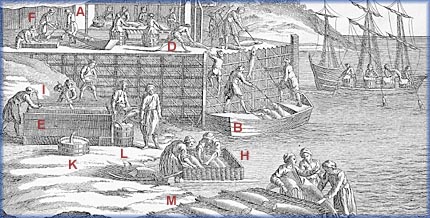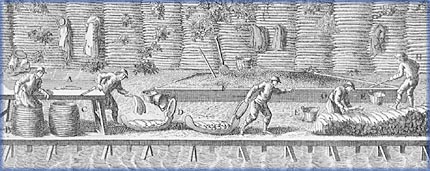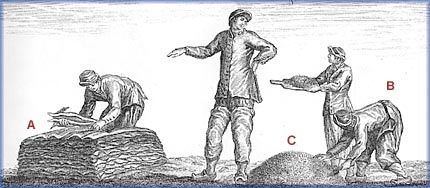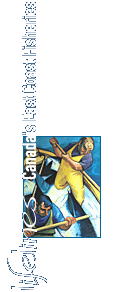|
The Preparation of Salted and Dried Cod
 he preservation and market
value of the cod depended on how well the fish was prepared. he preservation and market
value of the cod depended on how well the fish was prepared.
When the shallops returned, the cod was unloaded at the stage.
Apprentices took it to the header, who removed the head and the
viscera. The splitter then split the fish open, finished cleaning
it and removed the backbone. A boy deposited the livers in a vat,
where the oil was collected. After this initial preparation, the
salters packed the cod between two layers of salt.
A few days later, the salted cod was washed and stacked to drain.
When it was sufficiently drained, it was carried to the beach,
and placed on pebbles or flakes to dry. The fish took about ten
days to dry. It was turned over during the day, and stacked at
night and when it rained.
|

|
|
Crew working on the stage and the beach,
18th century
A Handling the cod |
B Unloading the fish at the stage using pews |
D Removing the heads and splitting the cod open |
E, I Stirring the livers to remove the oil |
F Salting the cod |
H Salted cod being washed |
K, L Oil being collected in barrels |
M Salted cod being dried on flakes
Based on Traité général des pesches,
by Duhamel du Monceau, in Encyclopédie, fisheries plates
(Paris: Éditions Panckoucke, 1793)
(Collection of Nelson Cazeils, Biarritz, France)
|

|
|
Preparation and initial salting of the cod,
18th century
This illustration shows cod being prepared on the stage. After
the head was removed, the fish was split open, cleaned, then taken
to the salter for the initial salting.
Based on Traité général des pesches,
by Duhamel du Monceau, in Encyclopédie, fisheries plates
(Paris: Éditions Panckoucke, 1793)
(Collection of Nelson Cazeils, Biarritz, France)
|

|
|
Cod being salted, 18th century
A An apprentice stacks the cod |
B Two boys fill small salt shovels for the salter |
C Pile of salt
From Traité général des pesches,
by Duhamel du Monceau, 1772
(National Library of Canada)
|
|
|
|



